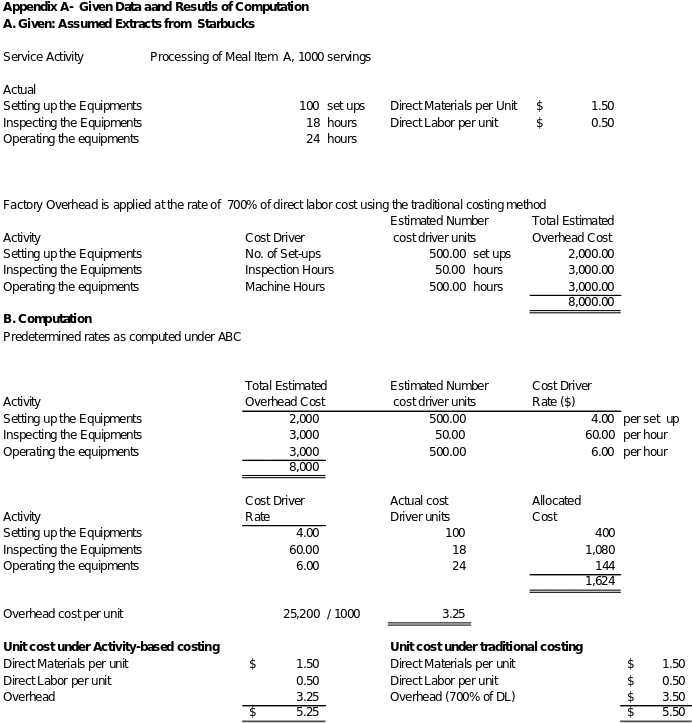Introduction
This paper seeks to identify the service in STARBUCKS that could use Activity Based Costing (ABC) and at least two activities for ABC and the appropriate cost drivers for those activities. This paper will also estimate rates for each cost driver. Since specific actual amounts could not be identified reasonable estimate was and the tool was applied as if the data were factual.
Discussion
The service that the company could use activity-based costing is the production or processing of one of its food items. The activities and their respective drivers for ABC include setting up the equipment as driven by the number of set-ups, inspection activities as driven by the number of inspection hours, and the actual running of the equipment as driven by the number of hours in use. The application rates for each cost driver are also shown in Appendix A. The period covered for the activity is the month of March 2008. The inputs used include variable unit costs of material and labor and total overhead estimated for the setting up the machines, conducting the inspections and running the machines, the actual number of Food items A processed as well as the estimated number of cost driver units for each activity.
The summary of given data and results of the computation made after applying the principles of activity costing are summarized in Appendix A.
The implication of results as shown in the Appendix is that the unit cost of processing under the given equipment appears lower if activity-based costing is used as compared with the traditional approach of where overhead for the factory was merely assigned 700% of the direct labor cost.
Evidence is available to assert that activity-based costing (ABC) is better than traditional costing. ABC has the capacity of assigning a cost to activities instead of to cost pools. Moreover, the appropriate activities are defined that involved careful analyses and that cost drivers needed to be extracted for each kind of appropriate activity. After dividing estimated unallocated overhead costs to cost drivers extracted and defined, the cost driver rate was calculated.
Compared with traditional costing, ABC effectively allocated unallocated fixed costs within the various activities that consume resources which had the effect of redefining the behavior of the fixed cost into variable cost and therefore making more costs relevant for decision making (Atkinson, A. et al, 2005,). The application above done for Starbucks could provide management to determine and control what are controllable which will help the company to implement a responsibility accounting that could hold managers responsible for their decisions. Such could help attain goal congruence for the company which is necessary for proper motivations.
Conclusion
It is observable above that the unit cost difference between traditional costing and activity-based costing as per Appendix A was only about $0.25 per unit. From the management’s point of view, the difference may not be material enough to justify the shift to activity costing. ABC costing is given as more complicated than traditional costing and its cost could outweigh the benefits. Viewed from a large scale of processing more food items, the difference in total amount may justify the adoption of ABC.

References:
Atkinson, Anthony, et al (2005), Management Accounting, Person Custom Publishing, New Jersey, USA.
Starbucks Coffee Company (2009), Annual Report of Starbucks for 2008. Web.